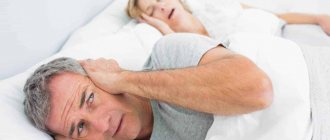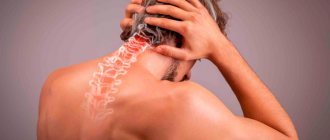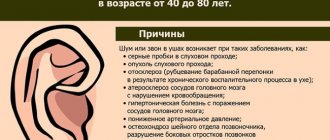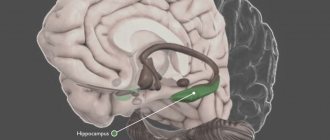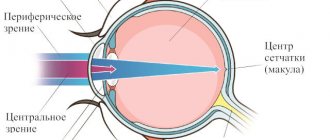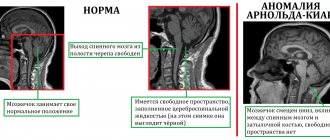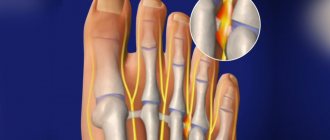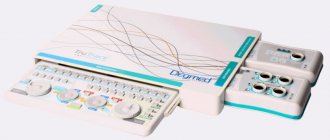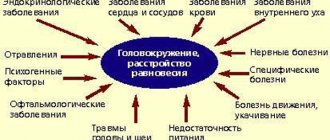The ear is an organ of hearing that performs very important functions in the human body. It provides the perception of sounds and their conduction, as well as orientation in space. Ripple or noise in the ear are symptoms of pathological changes in the auditory analyzer, the causes of which must be urgently determined in order to begin treatment in a timely manner. When there is a constant pulsation in the ear, a person becomes irritated and nervous, sleeps and eats poorly, and becomes depressed. These signs ultimately lead to even greater health problems: hearing impairment, mental disorders.
It can pulsate in both ears simultaneously or separately in each. The pulsation in the ear can be ringing, reminiscent of clicking, or dull, almost imperceptible. It is often accompanied by a feeling of congestion. In healthy people, the cause of painless pulsation in the ears, which occurs periodically, is stressful and conflict situations, physical and psycho-emotional stress, fluctuations in pressure and body temperature. In such cases, pulsating tinnitus is not a pathology and does not require special treatment. If it is heard constantly and is accompanied by pain, incoordination of movements, and the appearance of “spots before the eyes,” you should immediately visit a doctor. Such pulsation is a manifestation of a disease, the cause of which must be determined and eliminated.
Etiology
The causes of pulsation in the ear are very diverse. These include:
- Infectious and inflammatory diseases of the auditory analyzer,
- Closed and open head injuries,
- Vascular diseases - atherosclerosis, hypertension, various vascular malformations,
- Stress,
- Neoplasms of the head and neck,
- Wax plugs in the ears,
- Long-term treatment with antibiotics, especially ototoxic ones,
- Long-term use of non-steroidal anti-inflammatory drugs,
- Hormonal surge during pregnancy, menopause,
- Degenerative-dystrophic changes in the spine,
- Daily use of headphones
- Pressure surges during air travel, diving, mountain climbing,
- The natural process of aging of the body.
Consequences of head injuries
Injuries to the middle ear or head often cause throbbing pain caused by poor circulation in the damaged area. Typically, the victim begins to feel throbbing and pain several hours after the traumatic situation. In addition to these manifestations, trauma symptoms such as nausea, dizziness and vomiting may occur. The strength of the knock in such cases depends on the degree of swelling and the severity of inflammatory processes in the tissues of the hearing aid.
Typically, throbbing pain is felt on the side of the damaged ear (that is, only on the right or left). When you try to tilt your head or torso, the pain and knocking in the hearing organs intensify.
The treatment strategy for pulsation in the ear in such cases depends on the clinical case. It is determined by the doctor individually for each patient after a comprehensive examination (radiography, MRI of cerebral vessels, CT, etc.).
Diseases of the heart and blood vessels
Persons suffering from cardiac pathology quite often experience tinnitus, reminiscent of a heartbeat. The pulsation is especially acute when the patient climbs stairs or bends forward. He feels pressure in his head, lack of air, and noise in both ears.
- With hypertension , vascular tone is disrupted, capillaries become overfilled with blood, and systemic blood flow becomes difficult. The sound of blood “friction” through the vessels is perceived by a person as a pulsating noise. “It’s as if the heart is pulsating in the ears” - this is how patients characterize this phenomenon. If a hypertensive crisis develops, the flow of blood into the vessels of the inner ear becomes uneven. This stimulates the nerve endings, which also results in pulsation in the ears.
- Atherosclerotic processes lead to loss of elasticity of the vascular wall, which ceases to contract in the same rhythm as the heart. Such pathological pulsation becomes audible. If the ear is pressed against the pillow, it becomes especially noticeable. Patients with atherosclerosis complain of regular dizziness, noise and pulsation in the head, easy fatigue, poor memory, and hypertension.
- Violation of the structure and functioning of large arteries and veins , their narrowing or stratification changes the speed and direction of blood flow, which hits the walls of blood vessels. Patients claim that their ear throbs, but it does not hurt. Small aneurysms manifest themselves as pulsations in the head. The larger the size of the protrusion, the more pronounced these unpleasant sensations are.
Causes and symptoms of pulsation in the ears
This symptom is caused by pathologies of various systems and organs, and its elimination is achieved by combating the main ailment, the root cause. In professional circles, it is called “pulsatile tinnitus” and, according to some statistics, this symptom is observed in approximately 5% of adults.
Pulse pounding in the ears is often observed in older people and usually the occurrence of such a symptom indicates deterioration of hearing. Also, pulsating tinnitus can often be provoked by prolonged exposure to a significant noise factor (for example, the sound of a working machine in a factory, etc.).
Video: What causes tinnitus? 3 reasons
Otolaryngologists divide the causes of pulsation in the ears into physiological and pathological. In the first case, such a symptom is provoked by harmless factors and is eliminated on its own. Such physiological reasons include the following conditions: muscle contraction, movement. If the occurrence of tinnitus is caused by diseases and pathological conditions, then the appearance of this symptom indicates the need to examine and determine the root cause of the pounding in the ears.
Pathological causes of pulsation in the ears include the following ailments:
- pathologies of the heart and blood vessels;
- inflammatory diseases of the hearing organs;
- pathologies of the middle and inner ear;
- neoplasms of the brain, neck or hearing organs:
- consequences of head injuries;
- swelling during pregnancy.
At first, a person does not pay much attention to the occurrence of this symptom, but then such internal pulsation worsens the quality of audibility of external sounds. Over time, the patient becomes nervous, apathetic (even to the point of depression) and complains of sleep and appetite disturbances.
Clinically, pulsation in the ears is manifested by the symptoms that are characteristic of the disease that caused tinnitus. With high sensitivity to all sounds, knocking in the hearing organs may indicate stress or a nervous breakdown.
If a monotonous knocking occurs in the ears and the quality of hearing external sounds sharply deteriorates, then the symptom most likely indicates problems in the functioning of the circulatory system or an inflammatory disease of the hearing organs.
The level of pulsation that occurs in the ears may depend on blood pressure readings. In such cases, the pounding in the ears is clearly pulsating in nature.
Sometimes pounding in the ear is accompanied by pain and signs of fever. In such cases, most likely, the symptom is provoked by otitis media (ear inflammation). And if tinnitus is accompanied by frequent attacks of dizziness and impaired coordination of movements, then the patient will probably show signs of damage to the auditory nerve.
In addition, a pulse in the ears can also be felt due to the consequences of injuries or the development of a life-threatening disease such as a tumor of the brain or hearing organs. And in such cases, the help of a doctor should be immediate.
If you think about the danger of those diseases that can provoke sensations of pulsation in the ears, we can conclude that visiting a doctor in such cases should be mandatory and it is unacceptable to put it on the back burner. Only a specialist, after conducting an examination, will be able to make the correct diagnosis and prescribe treatment for the root cause of this unpleasant symptom!
Diseases of the ENT organs
Pulsation in the ear can occur with diseases of the ENT organs:
- Any part of the ear can become inflamed, as well as the Eustachian tube connecting it to the nasopharynx. Pathological changes in the auditory analyzer distort sound waves and reduce their perception. With otitis, the outflow of serous-purulent exudate is disrupted, an “echo effect” is created, internal noise increases, and blood pulsates. The patient has throbbing in the left ear due to left-sided inflammation of the auditory analyzer. If otosclerosis develops, in which the mobility of the auditory ossicles in the middle ear is impaired, then patients experience decreased hearing, dizziness and tinnitus.
- Labyrinthitis is an inflammation of the inner ear caused by the penetration of infection from chronic foci in the body. The main manifestations of labyrinthitis are vestibular disorders. In patients, coordination of movements is impaired, everything floats before the eyes, ataxia, nystagmus, and autonomic disorders occur: pallor, hyperhidrosis and dizziness. Irritation and death of sound receptors leads to pulsation in the ears, reversible hearing loss and even deafness.
- Hypersecretion of earwax often results in the formation of cerumen plugs, which must be removed promptly. Earwax blocks the ear canals, which causes hearing loss, inflammation and the appearance of pathological pulsation.
Possible complications
Pulsation in the ears and the inability to suppress it cause severe discomfort to a person. Prolonged stay in this state can cause mental disorders and lead to changes in feelings, perceptions, thinking and behavior. Complications that arise from auditory hallucinations may be the following:
- increased irritability;
- insomnia;
- memory impairment;
- impaired concentration;
- chronic fatigue;
- rarefied breathing;
- depressive state.
If the cause of noise effects in one ear is pathological processes, then the consequences of such a condition can be much more serious, even fatal. The presence of a tumor or neuroma of the auditory nerve can lead to complete or partial hearing loss. Infection of the middle ear threatens to spread the infection to other organs and systems, which is fraught with pulmonary edema and hypoxia. In the absence of timely medical assistance, complications that arise may be irreversible, so it is important to go to the hospital in time.
- Bitterness in the mouth
- Heel file
- Warm up before training at home
Traumatic injuries
Brain injuries are a dangerous condition that threatens human health and life. With TBI, the blood supply to the auditory organ is disrupted, swelling and other signs of inflammation occur. This leads to dysfunction of auditory cells, disruption of sound transmission and sound perception. The throbbing and pressing headache intensifies when the victim begins to move his head.
If there is a fall or blow to the head, it is necessary to conduct a tomographic examination to rule out a concussion. This is extremely important for patients who experience increased pulsation and loudness of noise, drumming, dyspeptic symptoms, and dizziness. TBI has a severe course and serious consequences. After discharge, patients continue to complain of dizziness, pulsation in the head, and headache for a long time.
Tumor of the brain or hearing organs
In cases where the pulsation that occurs in the ears is often accompanied by headaches and does not go away for a long time, examinations should be performed to exclude or confirm the possible presence of tumor processes of a benign or malignant nature in the brain, hearing organs or neck area. An increase in the tumor leads to increased pressure on nearby vessels, and if a large arterial vessel supplying blood to the inner ear or brain is subjected to such compression, the pounding of the pulse does not subside.
Usually, during tumor processes, pulsation occurs only on the right or left side, that is, where the tumor grows. If the neoplasm is localized in the cervical spine, then the pulse will be heard in both ears.
The combination of pulsation in the ears with symptoms such as weight loss, severe weakness, nausea and other manifestations of intoxication syndrome and tumor growth (pain, infiltration, etc.) is especially dangerous. Such a dangerous combination of manifestations may indicate the presence of cancer processes and requires immediate attention to an oncologist!
Osteochondrosis
Osteochondrosis is a degenerative-dystrophic disease of the spine, in which deformation of the vertebrae develops. Gradually, the distance between them decreases, the nerve roots and blood vessels of the neck are compressed by osteophytes. Blood stops circulating normally, nutrition, innervation of the brain and sensory organs are disrupted.
Immediately after an exacerbation, patients complain of congestion and constant tinnitus, reminiscent of a painless pulsation. It can be sharply expressed or, conversely, practically unnoticeable. In some cases it is tolerable, and in others it is acute, preventing a person from turning his head. Constant pounding in the ear makes patients feel stiff and immobile. Light pulsation causes minor discomfort in patients and does not cause any particular problems. Such symptoms are ignored by patients and remain unnoticed until a certain moment when it is impossible to turn the head. The pulsation may subside in an advantageous position of the head and appear again during active movements.
In addition to tinnitus, patients experience pain in the back of the head and temples, insomnia, ringing, whistling, clicking and crackling in the ears, visual acuity decreases, memory deteriorates, hands become numb, and blood pressure increases.
How to get rid of noise
Before starting treatment for pathology of the right ear, the exact cause of its occurrence should be determined. If the disease is determined to be idiopathic (the cause has not been established), therapy consists of taking sedatives and undergoing a course of physiotherapy. Special hearing aids can be used to mask unpleasant signals and relieve ear strain. During treatment, the presence of ear nerve irritants (loud music, alcohol, toxic drugs) should be limited.
To eliminate the pathogenic causes of noise, drug therapy, physiotherapeutic procedures and, if necessary, surgical intervention are used. If the factor provoking auditory signals is an oncogenic tumor, its removal and a course of radiation therapy are required. In case of blood supply disorders that provoke irritation of the auditory nerve of the right ear, along with traditional treatment methods, you can resort to traditional medicine recipes.
Drug treatment
After diagnosis and identification of the cause of the pathology, the doctor prescribes medications based on the clinical picture. The main drugs used in the treatment of diseases that provoke pulsating noise in the right ear are as follows:
| Activation of body systems | Treatment of otitis media | Removing wax plugs | Therapy for osteochondrosis | Normalization of the cardiovascular system and brain function |
| Sedatives – Persen, Tenoten | NSAIDs – Otinum, Otpax | Cerumenolytics – A-Cerumen, Otipax, Vaxol | NSAIDs – Voltaren, | Antihypoxants – Antisten, Actovegin |
| Glycosides – Strophanthin, Convallatoxin | Glucocorticoids – Anauran | Hydrogen peroxide | Nootropics – Vinpocetine, Phezam | Vasodilating agents - Vasobral |
| Antihistamines – Suprastin, Claritin, Loratidine | Antibacterial drugs and products containing antibiotics - Normax, Amoxiclav, | Nootropics – Cerebrolysin, Piracetam | ||
| Immunomodulators – Lykopid, Polyoxidonium | Probiotics – Linex, Acipol | Antihypertensive drugs – Bisoprolol, Maxonidine | ||
| Vitamins A, B1, B2 | Analgesics – Paracetamol, Ibuprofen | Diuretics - Hypothiazide |
Cerebrovasodilating agents are used to treat neurological disorders caused by circulatory disorders and accompanied by decreased hearing acuity. Drugs in this group include Vinpocetine. Taking this drug causes a decrease in blood pressure and normalizes blood supply to the brain:
- name: Vinpocetine;
- description: a vasodilator that helps improve the supply of glucose and oxygen to the brain, reduces blood viscosity, and has a relaxing effect on vascular smooth muscle;
- advantages: high efficiency, fast action;
- cons: presence of side effects.
To solve one of the most common problems that causes noise in the ear, ear drops are prescribed. This remedy is effective for the accumulation of sulfur secretion in the ear canal. A drug that promotes gentle and safe removal of the plug is RemoVax drops:
- name: RemoVax;
- description: allantoin-based drops have a softening effect on dense sulfur plugs, facilitating its leaching from the ear canal;
- pros: safe for patients of all age groups;
- cons: may cause dizziness.
Folk remedies
You can alleviate the condition of noise in the ear using traditional medicine recipes. Homeopathic remedies should be used as complementary therapy along with traditional treatment. Effective ways to eliminate unpleasant symptoms are compresses, instillation of decoctions of medicinal plants and taking infusions prepared according to the following recipes:
- A decoction of currant leaves. To prepare the product, you need to take equal parts of black elderberry flowers, lilac, and currant leaves. 2 tbsp. l. pour the mixture with 2 glasses of water and boil for 20 minutes. Cool the broth, strain and take 70 ml 3 times a day until the noise in the ear disappears.
- Viburnum juice compresses. Grind a few viburnum berries with a teaspoon of honey, wrap the mixture in a bandage or gauze and insert the resulting swab into the ear. The procedure is carried out daily for 14-21 days.
- Instillation of onion juice. Stuff one medium onion with cumin seeds and bake in the oven. Squeeze the juice from the cooled onion, which should be instilled in the ear, 2-3 drops twice a day until the unpleasant symptoms disappear.
Overwork
In healthy people, pulsating tinnitus is a sign of fatigue, exhaustion of the nervous system and chronic stress. At the end of a busy day of work, spent in a noisy and uncomfortable environment, your ears begin to throb. Intrusive noise at night prevents a person from falling asleep, relaxing and resting. Even basic sounds: the ticking of a clock, raindrops, breathing begin to irritate and seem loud. In this state, the movement of blood through the vessels is perceived as a pulsating noise. Tired people listen to everything, become depressed and begin to invent non-existent illnesses. If drug therapy does not help to cope with the problem, the help of a psychotherapist is necessary.
Diagnostics
To determine the cause and nature of the appearance of extraneous noise in the right ear, a set of diagnostic measures is carried out, which include collecting an anamnesis and using research techniques. During the interview with the patient, the doctor finds out the etiology of the noise and its nature. A necessary step during diagnosis is an examination, which includes the study of all parts of the right ear, ear canal and nerve.
Based on the clinical picture, the otolaryngologist determines further measures to identify the exact cause of noise in the right ear, and the following types of diagnostics can be used:
- palpation diagnostics - painful areas are determined using a metal rod;
- otoscopy – examination of the external auditory canal using an otoscope;
- audiometry – diagnosis of hearing acuity, carried out by an audiologist using an audiometer or tuning fork;
- Dopplerography - identifying disturbances in the movement of blood through vessels using ultrasonic waves;
- vestibulometry – assessment of the functioning of the vestibular apparatus using a set of procedures (caloric test, rotational, pressor, otolith reaction);
- angiographic study - an X-ray study using a radiopaque substance injected into the inner ear;
- Valsalva maneuver - assessment of the state of the autonomic nervous system through a test involving forced exhalation of air with the mouth and nose closed;
- dehydration tests - taking urine samples to determine osmolarity during long-term abstinence from drinking fluids;
- clinical blood test - the level of leukocytes is determined, an increase in which indicates the presence of infection;
- microbiological studies - the study of biological material (discharge from the right ear, accumulations of sulfur) for the presence of pathogenic microorganisms.
Other reasons
- Throbbing pain in the ears appears in patients suffering from cancer. Brain tumors and acoustic neuromas grow rapidly and compress the main neurovascular bundles of the neck. This leads to painless pulsation in the ears, unilateral hearing loss, and impaired facial expressions and speech.
- Hormonal changes occurring in the body of a pregnant woman lead to disruption of the water-electrolyte balance and swelling of the mucous membrane of the hearing organ.
- With age, atherosclerotic and degenerative processes develop in the body, the functions of auditory cells are disrupted, acoustic signals are distorted, and a constant background noise appears.
- Multiple sclerosis is a chronic disease characterized by destruction of the myelin sheath of nerve fibers and slow transmission of nerve impulses. Patients develop paralysis and paresis, breathing problems, and tinnitus.
- Depression and neuroses are manifested by psychogenic noise and pulsation in the ears. Stress, nervous tension, lack of sleep deplete the central nervous system, neurasthenia develops, which is manifested by increased fatigue, insomnia, irritability, depressive mood, pulsation and noise in the head, and headache.
- Long-term use of Gentamicin, Streptomycin, Haloperidol, Furosemide or Aspirin can cause damage to the structures of the inner ear and hearing impairment.
- Occupational hazards resulting in the development of hearing loss - increased noise levels at work, at the airfield.
- Persons with chronic sinusitis often complain that their ear is blocked and throbbing, pressing sensations appear in the head, sound perception worsens, autophony and monotonous noise appear. If the stuffy ear throbs and hurts a lot, you need to visit an ENT doctor. Since such symptoms are characteristic of otitis media, which has become a complication of inflammation of the maxillary sinus. And this is not surprising, because there is a close connection between the organs, facilitating the migration of infection.
- Poisoning with poor quality food, narcotic and sleeping pills is manifested by vomiting and diarrhea, fever, noise and pulsation in the ears, chills, lightheadedness, weakness, and convulsions.
- Alcohol abuse.
If the cause of pulsating tinnitus cannot be determined, it is called idiopathic.
Classification of tinnitus
To determine the cause of tinnitus and subsequently prescribe effective treatment, it is necessary to have an understanding of the nature of the noise and its intensity. The matter is complicated by the fact that this symptom in most cases is subjective, which imposes certain difficulties on diagnosing the disease that causes tinnitus.
Russian Soviet academician of the Russian Academy of Sciences I.B. Soldatov developed a classification based on the degree of noise, valuable for clinical medicine, which distinguishes four degrees:
- 1st degree – noise does not reduce performance, you can get used to it;
- 2nd degree – tinnitus is severe, especially at night;
- Grade 3 – the noise is constantly disturbing, the patient has to be distracted by it. Sleep is disturbed and irritability appears.
- Grade 4 – the noise is very difficult to tolerate and constantly disturbs the patient. Performance is almost completely absent.
In practice, this subjective assessment makes it possible to set the degree of tinnitus from mild to critical, which affects the specialist’s management of the patient.
Otorhinolaryngologists distinguish several types of tinnitus:
- Objective noise, which is also audible to others and directly to the specialist;
- Subjective is the most difficult. The noise is only audible to the patient;
- Vibration – occurs when any anatomical structure vibrates, such noise can be heard by a specialist.
- Non-vibrational - sounds that are a pathology of the auditory nuclei of the medulla oblongata.
Based on the localization of noise, several types can be distinguished and all of them are non-vibrational in nature:
- Central – generated in the center of the skull;
- Shifted to the periphery - the noise is heard only in one ear;
- Single-sided or double-sided.
Why is there tinnitus? There is also a classification according to the etiological factor, which correlates with the above reasons.
Acoustic trauma
Being in places with a lot of intense noise and high volume can lead to physiological adaptive hearing loss. Reduced sensitivity of the cochlear organ compensates for the intense sound wave and provides protection for the inner ear. Acoustic trauma in most cases resolves without the use of drug therapy.
Air pressure damage
It can occur due to sudden changes in pressure in gaseous and liquid media. For example, quite often barotrauma occurs in airplane pilots during a sharp climb or during parachute jumps. Barotrauma is often accompanied by dizziness, nausea and vomiting, general weakness and a feeling of stuffiness in the ears.
Otosclerosis
A chronic non-infectious disease of the hearing organ, occurring with the addition of degenerative changes in the cellular component of the inner ear and cochlear organ. Otosclerosis is a multifactorial disease and occurs more often in adults.
Arterial hypertension
The noise in this condition is accompanied by a headache and is pulsating in nature. Measuring blood pressure allows an accurate diagnosis. This symptom is typical for people in the older age group, as well as those who are overweight or obese.
Use of ototoxic drugs
The iatrogenic factor is quite rare, but if drugs are used carelessly or incorrectly, it can cause tinnitus. The use of antibiotics with ototoxic effects leads to inhibition of the functional activity of the auditory nuclei of the medulla oblongata and the occurrence of sensorineural hearing loss or complete loss of auditory function. Very often, the very first manifestation of the ototoxic effect of the drug is hearing loss with the addition of tinnitus.
Osteochondrosis
Tinnitus can also occur when blood flow through the vertebral arteries is impaired as a result of osteochondrosis. A decrease in blood flow to the pyramid of the temporal bone leads to a deterioration in the functioning of the neurosensory structures of the inner ear and the auditory pair of nuclei of the medulla oblongata.
Exostosis
Overgrowth of bone tissue that forms the inside of the external auditory canal. This pathological process leads to a change in the physical properties of the sound wave, its distortion, which can ultimately lead to the formation of noise.
Neuroma
A benign tumor from the nervous tissue of the auditory nuclei and tracts is asymptomatic for a long time, but as it increases in size it leads to compression of the nerve fibers running from the inner ear to the auditory nuclei and leads to noise and hearing loss. Also, due to the close proximity of the tumor process to the tissues of the cerebellum, symptoms such as dizziness may occur.
Sulfur plug
Earwax impedes the normal passage of sound waves through the external auditory canal, which leads to the formation of noise and a feeling of fullness in the ear. Tinnitus resulting from the presence of wax plugs can be easily eliminated by cleansing the external auditory canal or by rinsing it.
Treatment
Pulsation in the ear is not the main disease, but just a symptom. To get rid of pulsating tinnitus, you need to find out its cause. Treatment of pathologies manifested by pathological pulsation is carried out by otolaryngologists, neurologists, angiosurgeons, and oncologists.
Experts recommend that patients follow these rules:
- Keep your ears clean, remove wax plugs,
- Avoid drinking alcohol and smoking tobacco,
- Massage the neck and head to quickly relieve pulsation in the ear,
- Listen to music without headphones and at low volume,
- Take sedatives and psychotropic drugs if necessary,
- Take long walks in the fresh air
- Eat more fruits and vegetables
- Exercise,
- Carry out neck exercises
- Wear hats in the cold season,
- Normalize blood pressure levels,
- Avoid colds, get treatment on time,
- Always have a good mood.
These general recommendations, together with drug therapy, will alleviate the condition of patients and help prevent the recurrence of pulsation in the ears.
General restorative therapy
- Drugs that improve microcirculation of cerebral vessels - Vinpocetine, Cerebrolysin, Piracetam,
- Medicines that normalize heart function - “Korglikon”, “Strofanthin”, “Digoxin”,
- Sedatives – “Novopassit”, “Persen”, “Tenoten”,
- Physiotherapeutic procedures - magnetic therapy, ultrasound, solux, UHF heating, microcurrent therapy, intra-ear laser treatment.
Treatment of otitis media
- Ear drops containing NSAIDs – “Otipax”, “Otinum”; containing glucocorticoids - Anauran, Polidexa; containing antibiotic – “Normax”, “Otofa”; containing an antifungal agent - “Candibiotic”.
- Antibacterial therapy is carried out after receiving the results of a microbiological study of ear discharge and determining the sensitivity of the isolated pathogen to antibiotics. Patients are usually prescribed Amoxicillin, Amoxiclav, Ciprofloxacin, and Cefolexin.
- Antibacterial therapy should be accompanied by the intake of probiotics - “Linex”, “Acipol”, “Bifidumbacterin”.
- Painkillers and antipyretics to reduce symptoms - Paracetamol, Ibuprofen.
- Antihistamines for relieving edema - Suprastin, Claritin, Zirtec.
- Vasoconstrictor nasal drops to facilitate nasal breathing - “Vibrocil”, “Tizin”, “Nazivin”.
- Immunomodulators – “Immunorix”, “Licopid”, “Polyoxidonium”.
This is a comprehensive treatment for otitis of various localizations, allowing you to completely get rid of this pathology, and along with it, pulsation in the ear.
Removing wax plugs
You can remove wax plugs yourself at home. First, the cork needs to be soaked. This is done by instilling a 3% hydrogen peroxide solution into the ear. After some time, they move on to removing it. A warm decoction of medicinal herbs is taken into a large syringe without a needle, which is poured into the ear canal. At the same time, the head is tilted to the side of the sore ear so that the water pours back out. For three days after washing out the plugs, anti-inflammatory drops should be dripped into the ear to prevent the development of inflammation. If the plug is loose, it can be removed using A-Cerumen ear drops. They are instilled into the ear and waited for 3-5 minutes, then placed on the affected side. Dissolved sulfur flows out on its own.
Treatment of osteochondrosis
To treat osteochondrosis, patients are prescribed NSAIDs that reduce pain and other signs of inflammation - Voltaren, Nise, Ortofen. This is the basis of therapy, which is supplemented with effective pain relief, muscle relaxation, and vitamin therapy. Patients with osteochondrosis are recommended to exercise therapy, spinal traction, massage, acupuncture, and manual therapy.
Additional recommendations
To get rid of unpleasant pulsation in the hearing organs, you must adhere to the general rules of behavior for this ailment. The following recommendations can help improve the patient’s condition and should be followed while fighting the factor that provoked the pathology:
- It is necessary to periodically massage the neck, as it improves a person’s well-being and removes pulsation.
- You need to be more careful about ear canal hygiene.
- It is best to avoid ear sticks, as they can damage the tissue of the ear canal.
- Don't listen to music on headphones for too long or too often.
- It is advisable to give up bad habits, especially smoking and frequent drinking.
- There is no need to give up walking in the fresh air.
If a person wants to quickly get rid of discomfort in the ear, he must adhere to all the advice and requirements of the attending physician. Thanks to this, you can achieve recovery within 1-3 weeks. The duration of the treatment course will depend on the diagnosis and the presence of complications.
Causes and treatments
The audible pounding in the ears repeats the person's pulse. It is felt especially strongly at night, when there is silence. Tinnitus occurs in most cases due to diseases of the cardiovascular system. Other factors are associated with inflammatory processes, spinal diseases and fatigue.
A list of the main reasons will help you find out why you can clearly hear your heartbeat in your ears:
- arteriovenous malformation of cerebral vessels;
- high blood pressure;
- advanced atherosclerosis.
The stated causative factors are associated with disturbances in the functioning of the heart and vascular diseases. They contribute to increased tinnitus in a supine position and can pose a danger to the patient’s life. They are characterized by a rapid transition to a chronic form and gradual progression, provoking various disruptions in the body.
There are also less common reasons why you can hear a heartbeat in your ears:
- cervical osteochondrosis;
- chronic fatigue;
- exposure to certain drugs;
- the presence of inflammatory processes in the body.
The situation becomes dangerous if you can hear your heartbeat constantly in your ears. The patient must urgently consult a doctor to avoid complications.
High blood pressure
If high blood pressure is detected from 140/90 mm Hg. Art. We are talking about arterial hypertension. If it is detected only once, then the problem lies in the influence of irritating factors. A persistent increase in blood pressure indicates hypertension. It is characterized by narrowing of blood vessels, which leads to brain hypoxia. Due to the gradual increase in oxygen deficiency, the heart begins to pound in the ears.
The following factors influence the development of hypertension:
- excess weight;
- age over 60;
- use of hormonal drugs;
- smoking;
- alcohol consumption;
- incorrectly composed diet;
- physical inactivity (sedentary lifestyle).
When several factors are combined, the likelihood of developing blood pressure problems increases significantly. To make a diagnosis, a tonometer and an electrocardiograph (ECG) are used. It will be necessary to take several measurements on different days and times and study the electrical activity of the heart.
With arterial hypertension, the patient experiences ringing in the ears, spots before the eyes, dizziness, and tachycardia (rapid heart rate). Sometimes you may have a headache and sweating.
As a treatment, medications are usually used to reduce the load on the heart, dilate blood vessels and reduce the frequency of contractions:
- Beta-blockers (Sotalol, Timolol);
- Diuretics (“Torasemide”, “Furosemide”);
- ACE inhibitors (Captopril, Enalapril).
The attending physician should select medications based on the diagnostic results and the patient’s condition. It is necessary to combine drug treatment with lifestyle correction:
- make a proper diet;
- avoid stressful situations;
- give up alcohol;
- quit smoking;
- devote at least 7-8 hours a day to sleep;
- exercise at a moderate pace;
- avoid physical overload;
- lose weight.
Atherosclerosis
With atherosclerosis, fatty plaques form on the walls of blood vessels, narrowing their lumen. Disruptions in hemodynamics gradually appear. There is a pronounced palpitation in the ears as blood flows through the area of deposits. The disease is characterized by a chronic course. If treatment is not completed in a timely manner, various complications develop (cardiac ischemia, thromboembolism).
In the presence of atherosclerotic deposits in the cerebral vessels, the following symptoms appear:
- decrease in cognitive functions (memory, intelligence, attention);
- sleep problems;
- hearing loss;
- dizziness;
- headache;
- sense of anxiety;
- fast fatiguability.
Timely treatment of atherosclerosis allows you to avoid consequences. It includes the following groups of drugs:
- Statins (Pitavastatin, Rosuvastatin) slow down cholesterol synthesis.
- Nicotinic acid is prescribed to dilate blood vessels and relieve spasms.
- Fibrates (Gemfibrozil, Clofibrate) reduce the level of organic fats and normalize blood microcirculation.
Treatment of atherosclerosis lasts for 2 months. A repeat course is carried out after six months. Advanced cases require surgical intervention.
Arteriovenous malformation
Arteriovenous malformation is a congenital form of abnormal vascular communication. It is characterized by blood flowing from the arteries directly into the veins. The patient begins to hear tinnitus and suffer from high blood pressure. The presence of ringing is determined using a stethophonendoscope. The anomaly is accompanied by headache, fatigue, increasing weakness and dizziness. It is removed surgically. Medicines are used only as symptomatic treatment.
Osteochondrosis
Osteochondrosis is a disease characterized by deformation of the intervertebral discs. Its most dangerous and widespread location is considered to be in the neck area. The vessels supplying the brain pass through here. When they are pinched, the patient begins to hear ringing in the ears due to impaired blood supply. Osteochondrosis is accompanied by other symptoms:
- pain radiating to nearby tissues;
- decreased visual acuity;
- cognitive impairment;
- sleep problems.
The following instrumental methods are used for diagnostics:
- computed and magnetic resonance imaging (CT and MRI);
- radiography.
The treatment regimen consists of non-steroidal anti-inflammatory drugs (Diclofenac, Indomethacin) and tablets to improve metabolic processes (Vestibo, Cavintona). As a supplement, you can do massage and exercise therapy.
Inflammatory processes
If the focus of the noise is localized on only one side, we can talk about ear inflammation (otitis media). The pathological process is accompanied by the following symptoms:
- aching and stabbing pain;
- temperature increase;
- hearing loss;
- dizziness.
An otolaryngologist should be involved in making a diagnosis and drawing up a course of treatment. He will examine your ears using an otoscope and recommend a blood test. Additionally, X-rays of the temporal region may be required.
To eliminate the inflammatory process, antibacterial tablets (Ampicillin trihydrate, Netilmicin) and drops (Sofradex, Otipax) are used. Treatment is carried out under the strict supervision of a doctor. The patient should strictly follow the prescribed treatment regimen and come for examination at the specified time. The specialist will evaluate the result of treatment and, if necessary, extend the medication.
Overwork
Tinnitus does not have to be the result of illness. Sometimes it indicates overwork. Trying to quickly relax after a hard day, a person, being in an emotionally heightened state, listens to all surrounding sounds on a subconscious level. At this moment, he even hears the movement of blood through the vessels and feels the pulsation in the body.
Sedatives (Phenibut, Afobazol) will help relieve nervous tension and help you fall asleep faster. To avoid such situations, it is advisable to do breathing exercises and adjust your daily routine. In severe cases and in the presence of mental disorders, the help of a psychotherapist will be required.
